Apartment House
Not: Art Not: Non-Art Not: Both Art and Non-Art Not: Neither Art nor Non-Art - George Brecht
George Mačiunas’ seminal work from 1962 is a new project from Apartment House featuring an ensemble of 6 performers.
Performances so far have be at MADE Umeå, Sweden and the Flux Fest, Auditorium Parco della Musica, Rome and Cafe Oto, London.
It features a catalogue of sounds creating a richly concentrated, transparent and at times anarchic musical experience.
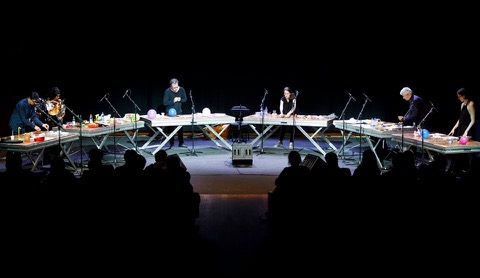
IRMA : an opera by Tom Phillips
“Netia Jones is the most imaginative director of opera working in Britain today” - The Observer
Director/Designer Netia Jones
Music Director/Sound Design Anton Lukoszevieze
Performed by Apartment House
Video by Lightmap
Produced by Sound UK
Tom Phillips’ Irma is a unique, intermedia artwork, a miniature "chance" opera brought to life through video projection, recordings, instruments, vocalists and an actor. The first performance of the new score, Opus XIIB, marks the 80th birthday of renowned artist and notable Peckham resident Tom Phillips RA. Set within the South London Gallery, where Phillips first showed his work as a student, Irma is inspired by his masterpiece A Humument, created from the pages of a Victorian novel bought for threepence on Peckham Rye in 1966. An hour long, Irma is an experimental artwork encompassing every aspect of an operatic performance in poetic, beautiful, enigmatic and miniature form. The costumes are inspired by Phillips’ artworks and his Victorian postcard collection held at the Bodleian Libraries. During the day the installation brings Phillips’ intricate visual score to life through an evocative combination of soundscape and video.
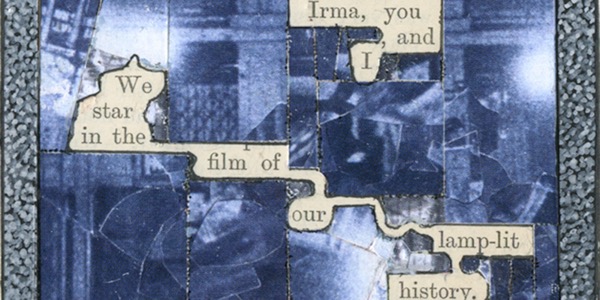

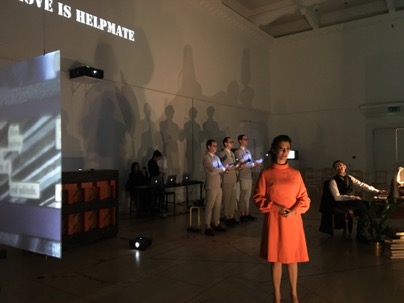
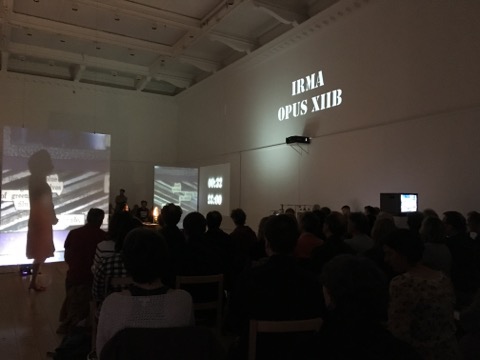
Vitalija Glovackyte
We are for a while is a 50 minute work for 4 performers, live electronics and lights, created as part of an 18 month residency with the London based experimental music group Apartment House.
Using as its starting point the concept and process of ‘recycling', much of the performers’ actions consist of using, dismantling, reconstructing and reusing found objects, broken instruments and lo-fi technology, accumulated from recycling centres, derelict buildings, skips, beaches, alleyways and other strange places over the course of one year. Expanding on the theme, pre-existing music from nearly 20 composers, sound artists and performers especially donated for this project will be ‘recycled’ and re-contextualised within this new work, all bound together by live lighting created with Michael Cutting and Sarah Hill.
Link to trailer on Vimeo
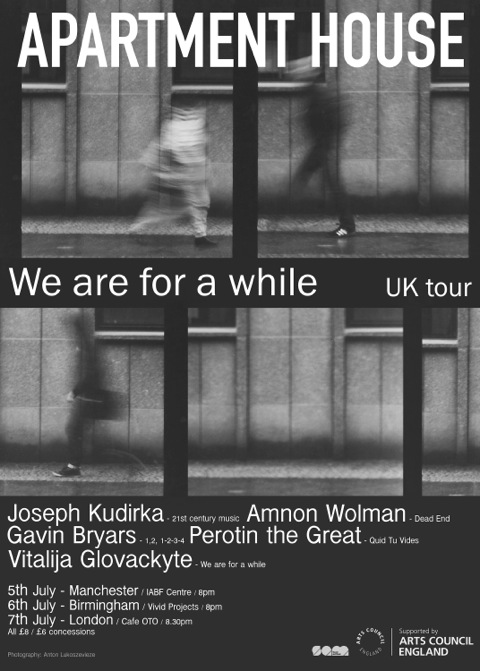
Saskia Moore
Dead Symphony for percussion, cello, harp, keyboard, vocalist and live-electronics
Premiere of Saskia Moore’s Dead Symphony, 6th July, 2013 Turner Contemporary, Margate
Apartment House were resident at Arts Centre, Melbourne. Australia 7th-10th August, 2013 featuring Saskia Moore’s Dead Symphony.
You can see a Youtube video of Saskia discussing her work here
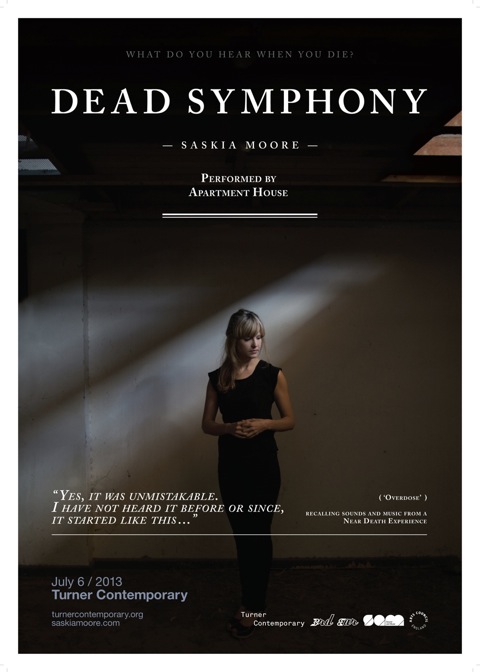
Jennifer Walshe
XXX Live_Nude_Girls!!! (2003) for 2 vocalists, 2 Barbie manipulators, 2 video camera operators, small ensemble and CD-playback
Youtube extract here
Premiere 5th October 2003, Dresden New Music Days. Subsequent performances Wien Modern, Oxford, Bruges, Rome and Ultima Festival, Oslo, 2009.
The idea behind it all comes from several things. I was thinking about when I was a kid and we would play with Barbie-type dolls. We would make these incredibly complex soap-opera plotlines with lots of death and violence and sex. It was all very dramatic. We didn't have a Ken, so we took one Barbie and cut her hair and drew on some stubble and dressed "Ken" in Barbie's most masculine outfit - a pink velour trouser-suit. "Ken" was then expected to go to bed with the other Barbies. I've been talking to lots of people about how they played with Barbies, and they all did the same things, which I find pretty interesting - generally, little girls playing with dolls is regarded as something very nice and innocent.
I don't really like dolls at all, but I liked playing with Barbies because you could create these massive stories and they also had pretty amazing accessories - we had a kitchen with tiny casserole dishes and little spatulas. There's a lot that has been written about the fact that Barbies don't look like regular women, but this was not really an issue for us when we were kids; bizarrely, because of the accessories and the clothes, Barbies came closer to reality than Lego or Transformers or stuffed toys.
I've been thinking about writing a larger-scale work for ages which could have elements of narrative and characters (however fantastical) but I didn't want to have opera singers or people acting on-stage and then I was reading about these Mozart marionette operas about a year ago and realised the idea of having a Barbie opera actually had some precedents. This was quite exciting and amusing at the same time.
The instrumentation is: two vocalists (not opera singers, people who do improvisation and extended techniques), five instrumentalists, two video-camera operators, two Barbie-manipulators. You have the Dream House (the house where Barbie lives - it's about 4 feet high, and open at the front, very easy to see into, much bigger than a normal doll's house) in the centre of the stage. The two people moving the Barbies are kneeling/sitting on the ground in front. The two camera operators move around behind them. The musicians are scattered around the stage. There are two screens on either side of the Dream House, which relay the video images. The images on the screen should be life-size if possible. Watching kids playing with dolls or teddybears is pretty fascinating, and I really like the idea of making a piece which has a very interesting visual aspect, seeing all these little dolls and tiny accessories blown up on a video screen to life size.
My idea is to create a piece about 35 minutes long. The music does not have to lock in with what's going on visually all the time. The singers sometimes have text (which I will choose/write), sometimes not. There is a narrative thread under the whole thing, sometimes it comes to the surface, at other times there are diversions from it. The performers (whether musical, video or doll) all have scores, with moments of controlled improvisation embedded in strict notation. Everybody uses Barbies or bits of them to play their instruments or make sounds at times.
©Jennifer Walshe, March 2003
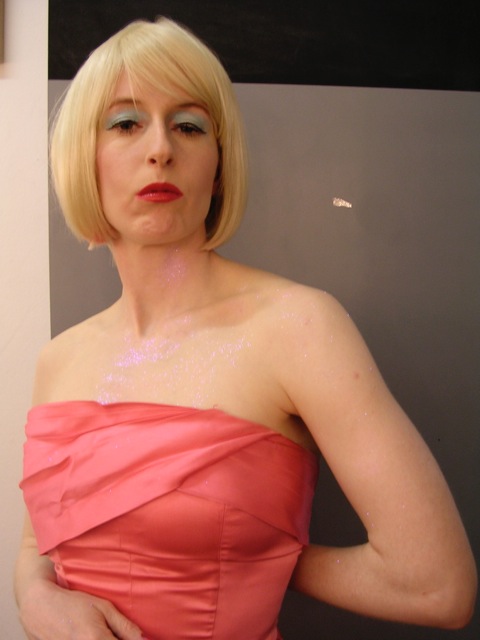
©Jennifer Walshe milkercorporation
Mauricio Kagel
Acustica (1968-70) for experimental sound producers
Acustica is perhaps the most refined example of Kagel's work within his invented genre of 'instrumental theatre'. The score notes that 'the piece calls for unorthodox musicians who are prepared to extend the frontiers of their craft' since few of the 'experimental sound devices' specified are conventional instruments and where conventional instruments are included they are to be played in extraordinary ways. Each instrumental action is, however, meticulously notated and the creation and/or modification of instruments are also shown in diagrams and photographs. What the score does not specify is the order in which the individual instrumental events are to be played; Kagel suggests instead that each performer should select the events that they want to perform and then discover in rehearsal how best to order them in combination both with the pre-recorded material and with the sounds of the other players. If the result owes obvious debts both to John Cage and to the theatre of the absurd, its subversive critique of received ideas on what constitutes music and musical instruments is above all typical of Kagel, contemporary master of irony. ©Christopher Fox
(below) Apartment House perform Acustica, BBC Radio 3/Sonic Arts Network Cut and Splice Festival, LSO St Luke’s, London, 2005. Performers are Andrew Sparling, John Lely, James Saunders, Tim Steiner, Anton Lukoszevieze and Sara Hubrich. Dress code was an attempt to adopt a 1972 ‘Polytechnic Lecturer’ style. Whether this was successful is doubtful.
Acustica ©The Wire
Franco Evangelisti
Die Schachtel (1962/63)
Sophiensæle, Ultraschall Festival, Berlin, 2006 dieschachtel
Die Schachtel (The Box), a co-production with the Sophiensæle/Labor für Theatre Musik, Berlin and Apartment House.
Music by Franco Evangelisti. Artistic Director/Video Production Daniel Kötter, Staging Paul Zöller, Choreography Petra Sabisch, Sound Design Daniel Teige, Music Direction Richard Baker.
DieSchachtel ©Daniel Kötter
Video Footage